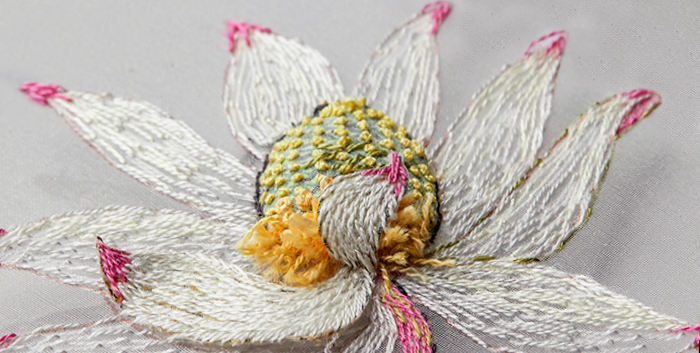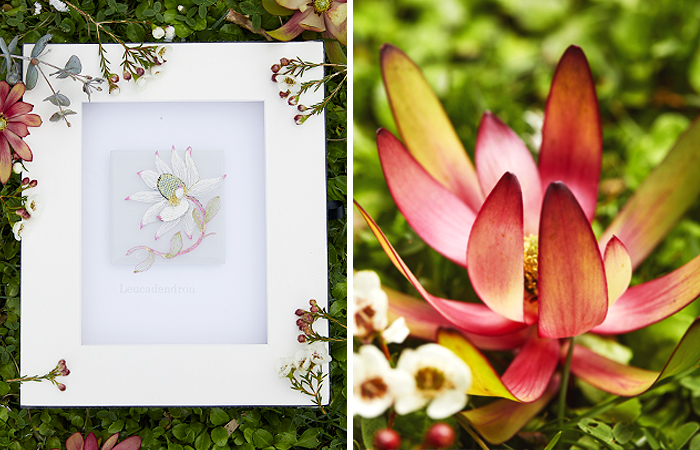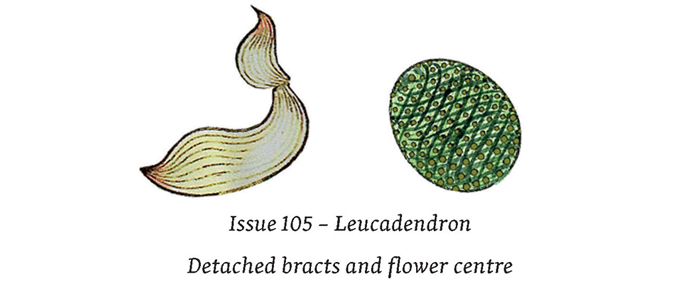Leucadendron by Gary Clarke
6th March 2020
Gary Clarke’s unusual study of the South African Leucadendron plant in Inspirations Magazine issue #105 is surprising in many ways. The plant itself is part of the famous Proteaceae family, known for its bold and long-lasting blooms and prized by gardeners for its low maintenance and hardiness.

This particular flower, white with delicate tips of pink on the bracts or petals, lends itself perfectly to the project which Gary has conceived.
What makes this project so unique is Gary’s choice of fabrics and materials. At first glance the Leucadendron flower seems to jump out of the frame in the same way that a traditional stumpwork piece would. However, on closer inspection, it can be seen that the main body of the flower is worked as surface embroidery.

What gives the piece its three-dimensional effect is the fact that it has been worked onto organza and then mounted over a ceramic tile.
This serves to lift the whole study right out of the frame.
There are some three-dimensional stumpwork elements to the flower, however even these have been worked in an unusual fashion. The central cone and two of the bracts are initially stitched over a sandwich of organza and printed paper. The printed paper provides pattern and depth, with the tactile effect achieved by careful placement of select stitches.

Once these unusual slips have been attached, the flower seems to immediately cry out to be cut and placed in a vase in the centre of a table.
Working on organza is far more delicate than working on heavier fabrics. Keeping your ground fabric tight on the frame is very important and, if you don’t already make a habit of doing it, start out with a brand new, unblemished and very sharp needle to minimise the risk of snags.

Naturally, organza is sheer resulting in the back of your work being just as visible from the front. This means no trailing threads and being careful when you start and finish a thread.

However, it also means that when working the running stitch, you only need a single pass to form an unbroken line. The impression of texture comes from the fact that some stitches sit above the organza and others below, achieving a unique texture.

Stitching the organza/paper slips also requires a very sharp needle to ensure that you pierce the paper cleanly. A fine pair of sharp scissors is also recommended when it comes to cutting out the pieces before attaching them to the main project.

The Leucadendren flower, originating from South Africa, is today known around the world and often adorns bouquets and sprays of flowers. Despite the fact that the natural blooms do last a long time, retaining their beauty often long after their companion blooms have faded, none will match up to the lasting beauty of Gary Clarke’s Leucadendron flower.
Floating in the frame in ethereal beauty, this unique piece of embroidery will challenge and delight in equal measure. If you’ve been looking for something new to extend your skills, you need look no further.
Did You Know?
To re-create Gary’s project Leucadendron from Inspirations issue #105, there are two design elements for the detached bracts and flower centre which require paper cut outs to be incorporated into your stitching.

The template to print these paper elements at home is available to download for FREE from our website below.
INS 105 Leucadendron Design Elements – FREE
Make Your Own Leucadendron

Step 1 – Purchase Project Instructions
Leucadendron by Gary Clarke is a dimensional, botanical embroidery worked on organza.
Inspirations Issue 105
Leucadendron – i105 Digital
Step 2 – Purchase Ready-To-Stitch Kit
The Inspirations Ready-To-Stitch kit for Leucadendron includes everything you need to re-create this delightful flower: Fabric (unprinted), fibre-fill, embroidery threads and needle.
Leucadendron – i105 Kit
Please Note: To cater for flexibility of purchase, instructions are not included with our kits. For step-by-step directions on how to create this project, please refer to the magazine/digital pattern.
